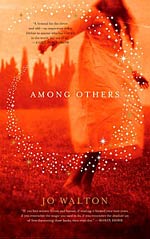
![]() Stella Atrium
Stella Atrium
2/2/2013
![]()
As my next review for the WWE 2013 Women in Sci-fi Genre Reading Challenge, I chose Jo Walton's Among Others, which I assumed was written in the 1980s since the main character discussed at length classic sci-fi stories available in Britain during that decade. I'm glad I finished the story before I read the press about Jo Walton and how she edged out JRR Martin for the Hugo Award last year for this work.
Her Hugo win is only logical considering that the story is more about engagement with classic sci-fi books than any other theme. The reviewers for the Nebula and Hugo awards must have thought Among Others was a smorgasbord!
I'm equally glad I didn't know the story was called a 'reverse Harry Potter' because I would not have started it for that very label. Derivative works are not my cup of tea. The story is written in the voice of a Welsh girl named Mori who doesn't know her father and hates her witch mother and is sent to an English boarding school that harbors NO magic – no possibility of magic since objects are held in common. I can see how that plotline gained the label.
**spoiler alert here**
Mori and her twin Mor spend a rich childhood communing with Welsh fairies and avoiding the cruel acts of a demented mother. The fairies enlist them to diminish the powers of the mother, but along the way Mor is killed and Mori is crippled.
Two facets of the story make it a classic. First is the unfolding explanation of the magic of English fairies and how 'it's so deniable', expounded through the filter of a sheltered 15-year-old who reads too much and is overly concerned with ethics. The second is the genuine responses to sci-fi stories Mori reads that are placed ahead of friendships among school chums, or reconciliation with a distant father, or a budding romance with a town boy.
I had read many of the sci-fi stories Mori claims to love (and at that same age), so I was in on the in-jokes. Defining the events of her life through examples from the stories – looking to Asimov and Zelazny for direction in a crisis – was unique, funny and delicious.
I liked that Walton choose the decade of the 1980s for her setting, ignoring world events but celebrating the gift of A Hitchhiker's Guide to the Galaxy, newly published. The world of Wales and Britain seemed quaint (County as Walton called it) and confined without the internet or a true connection with America that was the center of sci-fi publishing. The discovery of local fan conventions seems like finding Nirvani to Mori.
Sci-fi fans and would-be writers today discuss systems of magic all the time on Reddit – who got it right and who was copying from the other – high and low fantasy; soft and hard magic. Walton takes a respect-for-magic approach, and Mori worries that changing one event means so many events in the past and future must also change. Mostly, Mori uses magic, of which she seems strongly imbued, only when asked by the fairies and then only if the act does no harm. The one time Mori uses magic on her own as protection against her mother, and also requesting a karass, she worries later that all friendly gestures toward her are magic-bound.
This is a coming-of-age story, though, with no save-the-world tropes and few insights beyond what a perspicacious 15-year-old can glean from family and books. The book is brill, wholly charming and worth the investment of a rainy afternoon. And I ordered out-of-print Zelazny books for my next read.